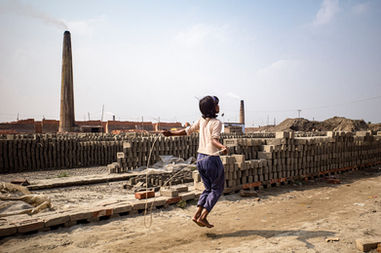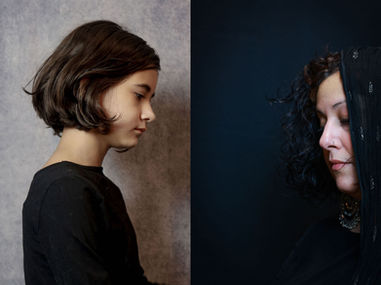
PICTORIAL STORY
August 2, 2024
IN-VISIBLE PAIN
Photography by Isabelle Coordes
Story by Melanie Meggs
In the profound and evocative series ‘In-Visible Pain,’ Isabelle Coordes delves deep into the enigmatic world of chronic pain, presenting a raw, unfiltered narrative through her art. This work is not just a collection of images; it is a visceral exploration of the silent, often misunderstood struggle that millions living with chronic pain endure daily. Isabelle, a self-taught amateur photographer from Münster, Germany, uses her keen eye and intimate understanding of human experience to make the invisible visible.
Through black and white self-portraiture, Isabelle brings to light the stark reality of living with chronic pain — a reality often dismissed by a world that requires physical evidence to believe in one’s suffering. Her photography transcends mere visual art; it is a compelling dialogue between the seen and the unseen, the spoken and the unspoken. In her images, we witness the haunting presence of pain, not as a mere symptom, but as a profound aspect of the human condition.
In this project, Isabelle offers insights into her visual diary. Documenting her chronic pain over the course of several months was a transformative experience for Isabelle. In using her camera as a catalyst, she was able to shed light on the parts of herself that had never been visible before, revealing layers of stored trauma and grief.
“When you become your own observer through the eye of the camera, you are gaining a new perspective on yourself. You may see yourself in a new light. You may even develop more compassion for yourself. And this can be a cathartic experience.”
Isabelle's background as a Speech-Language Therapist and her extensive studies in Human Medicine, Psychology, Communication Sciences, and Linguistics enrich her photographic narrative. Her systemic approach to understanding humans within their social networks is evident in her compassionate portrayal of isolation and resilience. These themes resonate deeply in her work, reflecting her belief that no one is an island and highlighting the interconnectedness of our experiences.
In In-Visible Pain, Isabelle’s camera acts as a mirror, revealing her inner struggles and encouraging viewers to join her on a personal journey. Her ability to capture the profound significance of her solitary existence and the intricate nuances of her pain demonstrates her deep empathy and keen observational skills. Each image serves as a testament to Isabelle as a visual storyteller, evoking deep contemplation and inviting diverse interpretations.
-min.jpg)
“You cannot objectify chronic pain. It is invisible. No brain scan proves it, no blood test shows it. There is no evidence for the hell you are going through. It’s all in your head. And it is mighty real.”
These words resonate deeply for many who suffer from chronic pain — a condition that defies conventional medical diagnostics and is often met with skepticism. Chronic pain is an enigma, a relentless tormentor that leaves no physical marks, no tangible evidence for others to see. It is a silent struggle, often dismissed as imagined or exaggerated. Yet, for those who endure it daily, its reality is undeniable.
For Isabelle, chronic pain has been a relentless companion since childhood. “I have been suffering from chronic pain since I was a little girl. The fact that nobody found any explanation for it made it clear to me that I had to endure it. It became a given to me which I learned to ignore as much as I could.” This adaptation became a survival mechanism for Isabelle, an ingrained response to a world that didn't understand. Ignoring the pain became second nature, a necessary means to navigate life.
However, chronic pain is not a consistent companion; it ebbs and flows, arriving unexpectedly and wreaking havoc on your daily life. Isabelle recounts years spent seeking every possible remedy, from medications to holistic approaches, all in the hope of finding a permanent solution. Yet, each attempt provided only temporary relief. “The pain always returned, more forceful, more frightening.”
The burden of chronic pain rarely comes alone, turning life into a battle on multiple fronts. Despite these challenges, Isabelle remained determined to meet responsibilities and live up to personal expectations. Distraction became a coping mechanism, a way to push through the darkness.
“Sometimes, the pain brought friends along, also known as Depression and Anxiety. It was getting more and more difficult to ignore it. Still, I kept myself busy with fulfilling my duties and meeting up with the standards I had set for my life.”
But there comes a breaking point, a moment when the body and mind can no longer endure the constant strain. “Until I realized that my body was no longer willing to obey. Until I realized that medication no longer brought relief. Until I realized that I had to make room for the stuff I had been pushing down for so long.” This profound realization marked a turning point in her journey.
This confrontation with reality took a profound and creative turn. Isabelle turned to self-portraiture, using the camera as a tool for introspection and revelation. “One step on the way for me was to make the invisible visible. In portraying myself throughout this process, I came face-to-face with my truth. I took off the mask and explored what was beneath it.”
Through the lens, Isabelle uncovered layers of denial and avoidance, recognising the vicious cycle of suffering. The camera became a mirror, reflecting hidden struggles that words could not capture.
“My camera became the only witness when there were no words left. For the first time in my life, I saw how I kept myself stuck in a vicious cycle. I began to understand that the pain is nothing to be pushed against, nothing to be ignored, but instead: a messenger that deserves to be heard.”
Embracing this perspective marked the beginning of a journey towards understanding and healing. By documenting the pain through self-portraiture, Isabelle has brought the unseen into focus, confronting the profound and personal truth of chronic pain. This powerful visual narrative not only offers a cathartic release but also invites viewers to witness and acknowledge the often dismissed reality of chronic pain.
In this body of work, we witness an artist bravely confronting her tormentor, turning her pain into a powerful visual and emotional narrative. The self-portraits uncover the hidden reality of chronic pain, inviting the viewer to witness and acknowledge its often denied existence. This work stands as a testament to the resilience of the human spirit and the transformative power of art in the face of profound personal struggle.

Isabelle Coordes’ work is a beacon of hope and understanding. Born from a lifetime of enduring chronic pain, Isabelle’s work challenges the societal norms that demand physical evidence for validation. Her camera became a tool for introspection and revelation, unveiling the hidden layers of trauma and resilience that define her journey. “One step on the way for me was to make the invisible visible,” she reflects, capturing the essence of her artistic mission.
Her dedication to portraying the diverse facets of life, coupled with her passion for connection, underscores the transformative power of art. As a member of Progressive Street and an ambassador for the 24hourproject, she champions the belief that together, we can be the change we want to see in the world.
Ultimately, Isabelle invites us all to contemplate our perceptions of pain, empathy, and the transformative potential of visual storytelling. Her dedication to shedding light on the often-overlooked realities of chronic pain is deeply appreciated by The Pictorial List. We commend her unwavering spirit and commitment, which serve as a potent force for cultivating empathy and igniting profound social change through the medium of art.

The views, thoughts, and opinions expressed in the text belong solely to the author/s, and are not necessarily shared by The Pictorial List and the team.




































